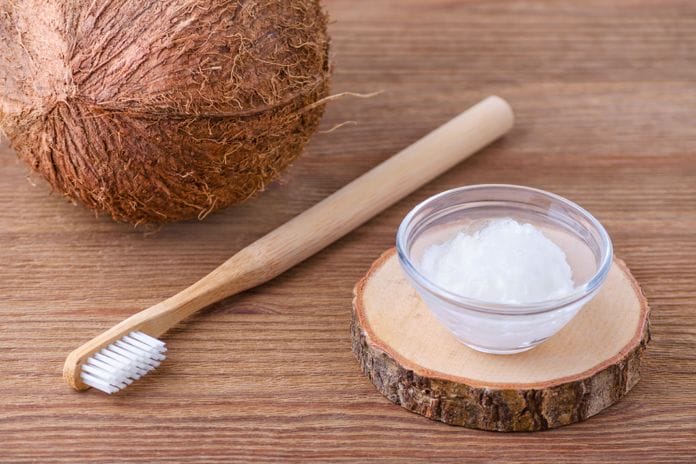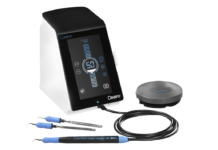“I brush once a day and am not the best flosser, but let me tell you, I started to oil pull for twenty minutes every day, and my teeth have never felt better!”
My patient looked at me, waiting for some kind of confirmation that this was a good home care routine, while I examined her teeth and gingiva. I had to admit I thought her teeth looked whiter than usual, but she still had generalized bleeding in the posteriors per her usual check-ups. This was not the first “oil puller” I had seen in private practice, and I was ashamed to admit that although I had done a little research, I still did not have a concrete answer to oil pulling. What exactly is oil pulling? Where did it come from? Does it work? These are all questions that will help clinical hygienists provide answers to curious patients asking about this home care technique.
The act of oil pulling can be dated back thousands of years in India, where it was included in a holistic system of medicine called Ayurveda6. The act of oil pulling involves putting a tablespoon of oil, usually coconut or sesame oil, in the mouth and swishing the oil between the teeth and throughout the oral cavity without swallowing for twenty minutes. The oil is said to “pull the toxins out of the mouth,” which detoxifies and purifies the entire human body7.
As hygienists, we know that there is a huge systemic link between the mouth and the body, so the idea that keeping the mouth clean to keep the body healthy is something we all can back up.
But does oil pulling actually remove the bacteria associated with caries and gum disease? And if it does, is it more effective than traditional methods, such as flossing and brushing? According to the American Dental Association, the short answer is there is just not enough research conducted to support oil pulling as an effective home care technique4,5.
That being said, a recent article published in September of 2017 reports positive effects of oil pulling in relation to different conditions in the mouth, such as dental caries, gingivitis, halitosis, and even thrush2. Evidence provided pointed to a small, randomized, controlled trial that showed a decrease in modified gingival index scores and plaque scores following oil pulling therapy when compared to chlorhexidine group at weeks one and two1. However, the chlorhexidine control group showed a reduction in S. mutans after the 24-hour mark, the 48-hour mark, and after one and two weeks1.
Additionally, it was not addressed whether it was the actual oil reducing bacteria or if it was the act of swishing alone.
Perhaps swishing with water that often and for that long, every day, might reveal the same results as swishing with oil. The 2017 study went on to further show that chlorhexidine can cause side effects, like staining, whereas oil pulling has no reported side effects other than a sore jaw if the oil is swished too vigorously2. They did not address the serious potential side effects from oil pulling, such as TMJ issues, vomiting, diarrhea, upset stomach and lipoid pneumonia. Lipoid pneumonia is a type of lung inflammation that can occur when lipids enter the bronchial tree through inhalation or aspiration of oils3. Outside of the potentially harmful side effects of oil pulling on the body, constantly spitting oil down the sink will eventually cause pipes to clog. All of these risky side effects should be mentioned to patients when they are considering oil pulling as a daily practice.
Another thought for hygienists to consider is the rationale of oil pulling to cure periodontal disease. Patients with periodontal disease usually have pockets greater than 3 millimeters, and dwelling deep in these pockets are virulent anaerobic bacteria. Mouth rinse can only reach 1-2 millimeters into the sulcus, so how can oil reach deeper? While the act of swishing could possibly disrupt supragingival bacterial colonies, how does oil pulling reach deeper subgingivally into periodontal pockets and disrupt virulent anaerobic bacteria?
It’s hard for us as hygienists to not mentally roll our eyes when a patient tells us about their new favorite holistic technique they’ve adopted into their homecare routine. We’ve spent years studying the best ways to reduce pathogenic bacteria in the mouth and spend our days relaying that information to patients. After researching oil pulling further, I now try to listen and identify what patients are trying to accomplish with oil pulling, and most commonly the answer is healthy teeth and gums. Once they tell me they oil pull to get healthy teeth and gums, I can promptly tell them the best way to accomplish this goal is by cleaning interdentally and brushing. I praise them for their ability to spend 20 minutes per day on a technique, but gently remind them that there is a reason the ADA does not approve oil pulling. I mention they assume potential risks, including gastrointestinal issues and lipoid pneumonia, by practicing oil pulling.
Knowing the origin of oil pulling, how it is practiced, and the arguments claiming the benefits, allow me to formulate a thoughtful response when confronted with “oil pullers.” I am interested to see further studies regarding oil pulling, but will continue to steer patients away from this practice and towards time-tested practices that are backed by the ADA and reliable research, like brushing and cleaning interdentally.
References
- Asokan, S., et al. Effect of oil pulling on Streptococcus mutans count in plaque and saliva using Dentocult SM Strip mutans test: a randomized, controlled, triple-blind study. J Indian Soc Pedod Prev Dent.2008 Mar;26(1):12-7. Retrieved from https://www.ncbi.nlm.nih.gov/pubmed/18408265
- Int J Health Sci (Qassim). 2017 Sep-Oct;11(4):65-70.Oil pulling and importance of traditional medicine in oral health maintenance.
- Muneyoshi, K., et al. Exogenous lipoid pneumonia caused by repeated sesame oil pulling: a report of two cases. BMC Pulm Med. 2015; 15: 135. Retrieved from https://www.ncbi.nlm.nih.gov/pmc/articles/PMC4628246/
- Natural Teeth Whitening: Fact vs. Fiction. Mouth Healthy (Brought to you by the American Dental Association). Retrieved from http://www.mouthhealthy.org/en/az-topics/w/natural-teeth-whitening
- Oil Pulling. Mouth Healthy (Brought to you by the American Dental Association). Retrieved from http://www.mouthhealthy.org/en/az-topics/o/oil-pulling
- Sharma S. Ayurveda and health. In: Sharma PS, editor. Realms of Ayurveda. 1st ed. New Delhi: Arnold-Heinemann Publishers; 1979. pp. 117–34.
- Singh A., Purohit B. Tooth brushing, oil pulling and tissue regeneration: a review of holistic approaches to oral health. J Ayurveda Integr Med. 2011;2:64–68. [PubMed]
- Lakshmi T, Rajendran R, Krishnan V. Perspectives of oil pulling therapy in dental practice. Dent Hypotheses. 2013;4:131.










